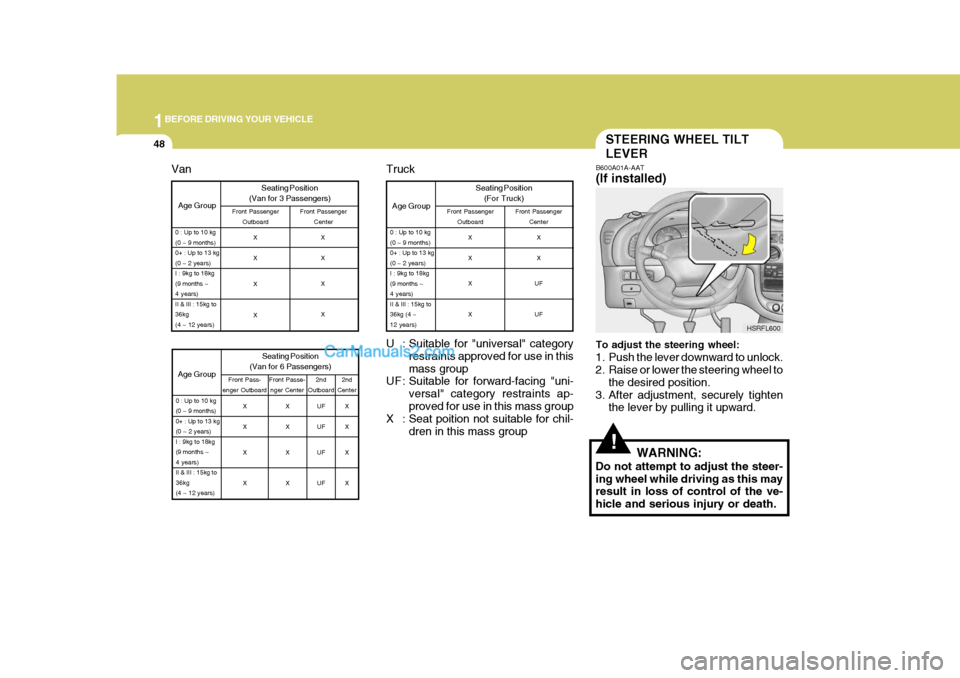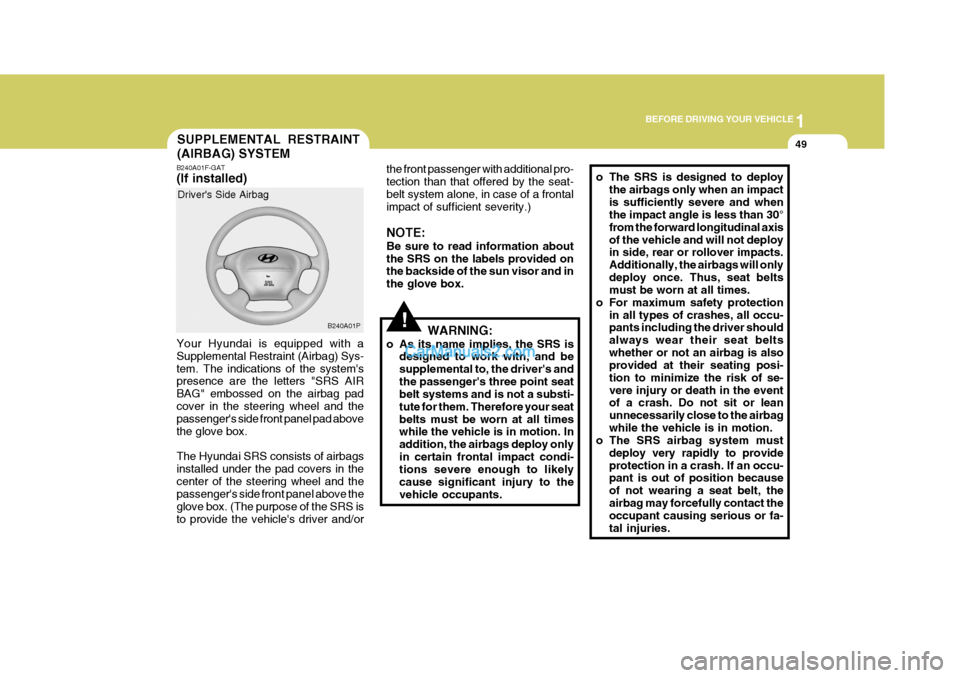2005 Hyundai H-1 (Grand Starex) wheel
[x] Cancel search: wheelPage 15 of 205

Before Driving Your Vehicle Safety Checks ................ 1-2
Running-in Recommendations ..................................... 1-2
Vehicle Identification Number (VIN) ............................. 1-4Keys.............................................................................. 1-6
Immobilizer System ...................................................... 1-6
Illuminated Ignition Switch ......................................... 1-11
Door ............................................................................ 1-12
Hold Open Lock System ............................................ 1-13
Central Door Locks ..................................................... 1-14
Theft-alarm System .................................................... 1-15
Tail Gate/Rear Gate/Side Gate .................................. 1-19
Hood Release ............................................................. 1-23
Remote Fuel-filler Lid Release ................................... 1-24
Window ....................................................................... 1-25
Seats .......................................................................... 1-28
Seat Belts ................................................................... 1-40
Child Restraint System............................................... 1-44
Steering Wheel Tilt Lever ........................................... 1-48
Supplemental Restraint (Airbag) System ................... 1-49
BEFORE DRIVING YOUR VEHICLE
1
1
Page 18 of 205

1BEFORE DRIVING YOUR VEHICLE
4
B070A01P-GAT MAINTENANCE It is necessary to maintain your vehicle in top operating condition in order to enjoy safe and pleasant driving.Some maintenance items can be done by the owner (Consumer information), while others should be done only by anauthorized dealer (periodic inspection and maintenance). For the maintenance items to be doneby the owner, prepare the appropriate materials and tools and follow the pro- cedures given in the "Consumer infor- mation" section of this manual. However, the periodic inspection andmaintenance should not be attempted by the owner, but should be done by an authorized HYUNDAI dealer.Correct performance of the periodic inspection and maintenance items re- quires specialized knowledge andequipment. Having these items performed by an authorized HYUNDAI dealer with thelatest technology and equipment will ensure that your vehicle is maintained for optimum performance, economy,and safety. In addition, having all periodic inspec-tion and maintenance done by an au-thorized HYUNDAI dealer is a prereq- uisite for validity of the warranty on your vehicle in the event of a claim.Refer to the separate "Service Book- let" for the periodic inspection and maintenance items and intervals. B080A01P-GAT INSTALLATION OF ACCESSO- RIES Consult an authorized HYUNDAI dealer when installing accessories.
o Installation of some accessories
may be restricted by regulations.
o Improper installation of electrical
parts could cause fire.
o Never use tires or wheels which do not meet specifications. For wheel and tire sizes, refer to the"CONSUMER INFORMATION" section of this manual.
VEHICLE IDENTIFICATION NUMBER (VIN)
B050A02P-GAT The vehicle identification plate is at- tached on the fender inner panel asshown in the illustration. The vehicle identification number (VIN) is the num- ber used in registering your car and inall legal matters pertaining to its own- ership, etc. HSRFL049
Page 62 of 205

1BEFORE DRIVING YOUR VEHICLE
48STEERING WHEEL TILT LEVER
!
B600A01A-AAT (If installed) To adjust the steering wheel:
1. Push the lever downward to unlock.
2. Raise or lower the steering wheel to the desired position.
3. After adjustment, securely tighten the lever by pulling it upward.
WARNING:
Do not attempt to adjust the steer- ing wheel while driving as this may result in loss of control of the ve- hicle and serious injury or death. HSRFL600
U : Suitable for "universal" category restraints approved for use in thismass group
UF : Suitable for forward-facing "uni-
versal" category restraints ap-proved for use in this mass group
X : Seat poition not suitable for chil-
dren in this mass group
Age Group
0 : Up to 10 kg (0 ~ 9 months)0+ : Up to 13 kg(0 ~ 2 years)I : 9kg to 18kg(9 months ~4 years)II & III : 15kg to36kg (4 ~12 years)
Truck Seating Position(For Truck)
Front Passenger Outboard Front Passenger
Center
X X X X X X
UF UF
Age Group Seating Position
(Van for 3 Passengers)Front Passenger Outboard Front Passenger
Center
0 : Up to 10 kg (0 ~ 9 months)0+ : Up to 13 kg(0 ~ 2 years)I : 9kg to 18kg(9 months ~4 years)II & III : 15kg to36kg(4 ~ 12 years)
X X X X X X X X
Age Group
0 : Up to 10 kg (0 ~ 9 months)0+ : Up to 13 kg(0 ~ 2 years)I : 9kg to 18kg(9 months ~4 years)II & III : 15kg to36kg(4 ~ 12 years)
Van
2nd
Center
2nd
Outboard
Seating Position
(Van for 6 Passengers)
Front Pass-
enger Outboard Front Passe-
nger Center
X X X X X X X XUF UF UF UFX X X X
Page 63 of 205

1
BEFORE DRIVING YOUR VEHICLE
49SUPPLEMENTAL RESTRAINT (AIRBAG) SYSTEM
B240A01F-GAT (If installed) Your Hyundai is equipped with a Supplemental Restraint (Airbag) Sys-tem. The indications of the system's presence are the letters "SRS AIR BAG" embossed on the airbag padcover in the steering wheel and the passenger's side front panel pad above the glove box. The Hyundai SRS consists of airbags installed under the pad covers in thecenter of the steering wheel and the passenger's side front panel above the glove box. (The purpose of the SRS isto provide the vehicle's driver and/or Driver's Side Airbag
B240A01P
!
the front passenger with additional pro- tection than that offered by the seat-belt system alone, in case of a frontal impact of sufficient severity.) NOTE: Be sure to read information about the SRS on the labels provided on the backside of the sun visor and in the glove box.WARNING:
o As its name implies, the SRS is designed to work with, and besupplemental to, the driver's andthe passenger's three point seat belt systems and is not a substi- tute for them. Therefore your seatbelts must be worn at all times while the vehicle is in motion. In addition, the airbags deploy onlyin certain frontal impact condi- tions severe enough to likely cause significant injury to thevehicle occupants.o The SRS is designed to deploy
the airbags only when an impact is sufficiently severe and when the impact angle is less than 30° from the forward longitudinal axisof the vehicle and will not deploy in side, rear or rollover impacts. Additionally, the airbags will onlydeploy once. Thus, seat belts must be worn at all times.
o For maximum safety protection
in all types of crashes, all occu-pants including the driver should always wear their seat beltswhether or not an airbag is also provided at their seating posi- tion to minimize the risk of se-vere injury or death in the event of a crash. Do not sit or lean unnecessarily close to the airbagwhile the vehicle is in motion.
o The SRS airbag system must
deploy very rapidly to provideprotection in a crash. If an occu- pant is out of position because of not wearing a seat belt, theairbag may forcefully contact the occupant causing serious or fa- tal injuries.
Page 64 of 205

1BEFORE DRIVING YOUR VEHICLE
50
The airbag modules are located both in the center of the steering wheel andin the front passenger's panel above the glove box. When the SRSCM de- tects a considerable impact to the frontof the vehicle, it will automatically de- ploy the airbags. Upon deployment, tear seams molded directly into the pad covers will sepa- rate under pressure from the expan-sion of the airbags. Further opening of the covers then allows full inflation of the airbags. A fully inflated airbag in combination with a properly worn seat belt slowsthe driver's or the passenger's forward motion, thus reducing the risk of head or chest injury. After complete inflation, the airbag immediately starts deflating, enablingthe driver to maintain forward visibility.
The SRS service reminder indicator (SRI) on the instrument panel will blink for about 6 seconds after the ignitionkey is turned to the "ON" position or after the engine is started, after which the SRI should go out.B240B02L
B240B03L
B240B02P-AAT SRS Components and Functions The SRS consists of the following com- ponents:
- Driver's Side Airbag Module
- Passenger's Side Airbag Module
- SRS Service Reminder Indicator(SRI)
- SRS Control Module (SRSCM)
The SRSCM continually monitors allelements while the ignition is "ON" todetermine if a frontal or near-frontal impact is severe enough to require airbag deployment. B240B01L
Page 66 of 205

1BEFORE DRIVING YOUR VEHICLE
52
o For cleaning the airbag pad cov-
ers, use only a soft, dry cloth or one which has been moistened with plain water. Solvents orcleaners could adversely affect the airbag covers and proper deployment of the system.
o No objects should be placed over or near the airbag modules onthe steering wheel, instrumentpanel, and the front passenger's panel above the glove box, be- cause any such object couldcause harm if the vehicle is in a crash severe enough to cause the airbags to inflate.
o If the airbags inflate, they must be replaced by an authorizedHyundai dealer.
o Do not tamper with or discon- nect SRS wiring, or other com-ponents of the SRS system. Do-ing so could result in injury, due to accidental inflation of the airbags or by rendering the SRSinoperative.
!WARNING:
o Extreme Hazard! Do not use a rearward facing child restraint on a seat protected by an airbag in front of it!
o Modification to SRS components
or wiring, including the additionof any kind of badges to the pad covers or modifications to thebody structure, can adversely affect SRS performance and lead to possible injury. B240C01HP
B240C01HP-GAT SRS Care The SRS is virtually maintenance-free and so there are no parts you cansafely service by yourself. The entire SRS system must be inspected by an authorized Hyundai dealer 10 yearsafter the date that the vehicle was manufactured. Any work on the SRS system, such as removing, installing, repairing, or any work on the steering wheel must beperformed by a qualified Hyundai tech- nician. Improper handling of the SRS system may result in serious personalinjury.
Page 69 of 205

3
Before starting the Engine .......................................... 3-2 Precaution for Exhaust Fumes While
Starting and Driving .................................................... 3-2
To Start the Engine ..................................................... 3-3
Key Positions ............................................................... 3-3Starting........................................................................ 3-4
Manual Transmission .................................................. 3-7
Automatic Transmission .............................................. 3-9Driving with Electronic Dual-Range Automatic
Transmission ............................................................ 3-13
Four-Wheel Drive (4WD) ........................................... 3-15
Brake System ............................................................ 3-19
Anti-Lock Brake System (ABS) ................................. 3-23
Back Warning System ............................................... 3-24
Driving for Economy .................................................. 3-25
Smooth Cornering ..................................................... 3-28
Winter Driving ............................................................ 3-28
Additional Equipment ................................................ 3-31
Locking Differential .................................................... 3-31
STARTING AND OPERATING
3
Page 71 of 205

3
STARTING AND OPERATING
3
5. Avoid idling the engine for prolonged
periods with people inside the car. If it is unavoidable, however, be sure to do so in an open area and adjust the heating or cooling system toforce outside into the vehicle.
6. Make sure that the ventilation air
intakes located just in front of thewindshield are kept clear of snow, ice, leaves or other obstructions, to assure proper operation of the ven-tilation system.
7. Get the back door closed while driv-
ing. An incompletely closed backdoor may cause exhaust fumes to be drawn into the vehicle. If you must drive with the back door opento accommodate a large object, close the windows, open the dash- board vents and have the heating orcooling system deliver fresh air into the vehicle by turning the fan to high speeds with the air intake controllever set in the "Fresh" position (Mini- bus, Van).
!
KEY POSITIONS
C040A01A-AAT
C040A01E-1
LOCK
ACC
ON
START
WARNING:
The engine should not be turned off or the key removed from the ignition key cylinder while the ve-hicle is in motion. The steering wheel is locked by removing the key.
o "START" The engine is started in this position. It will crank until you release the key.TO START THE ENGINE
C030A01A-GAT COMBINATION IGNITION SWITCH Before starting the engine:
o If your Hyundai is equipped with a manual transaxle, place the shift lever in neutral and depress the clutch pedal fully.
o If your Hyundai has an automatic transaxle, place the shift lever in "P"(park).
o To start the engine, insert the igni- tion key and turn it to the "START"position. Release it as soon as the engine starts. Do not hold the key inthe "START" position for more than 15 seconds.
NOTE: For safety, the engine will not start if the shift lever is not in "P" or "N" Position (Automatic Transmission).